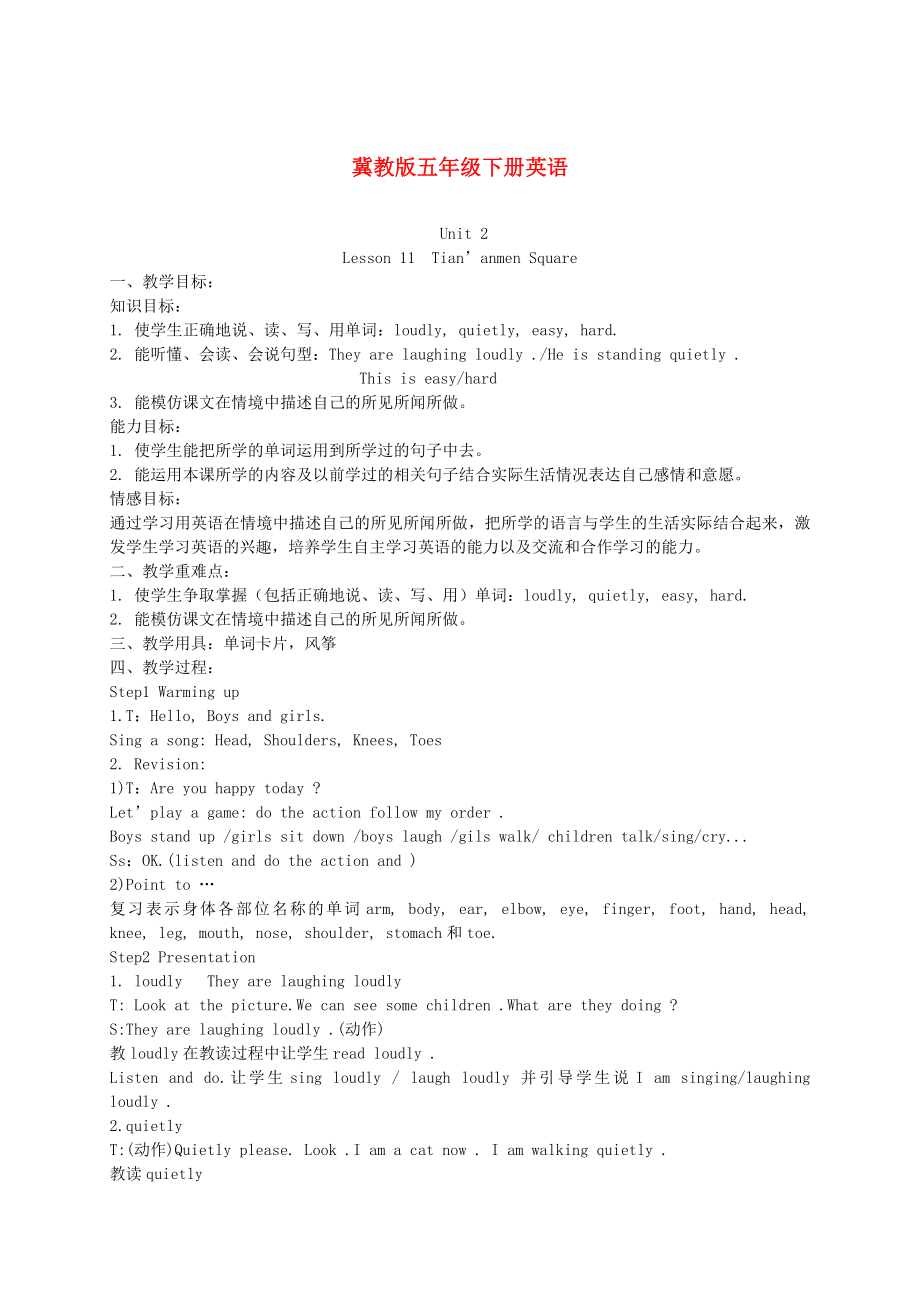《五年級(jí)英語(yǔ)下冊(cè) Unit 2 Lesson 11(2)教案 冀教版》由會(huì)員分享��,可在線閱讀�,更多相關(guān)《五年級(jí)英語(yǔ)下冊(cè) Unit 2 Lesson 11(2)教案 冀教版(3頁(yè)珍藏版)》請(qǐng)?jiān)谘b配圖網(wǎng)上搜索。
1�����、冀教版五年級(jí)下冊(cè)英語(yǔ)
Unit 2
Lesson 11 Tian’anmen Square
一���、教學(xué)目標(biāo):
知識(shí)目標(biāo):
1. 使學(xué)生正確地說(shuō)�、讀�����、寫(xiě)����、用單詞:loudly, quietly, easy, hard.
2. 能聽(tīng)懂、會(huì)讀、會(huì)說(shuō)句型:They are laughing loudly ./He is standing quietly .
This is easy/hard
3. 能模仿課文在情境中描述自己的所見(jiàn)所聞所做����。
能力目標(biāo):
1. 使學(xué)生能把所學(xué)的單詞運(yùn)用到所學(xué)過(guò)的句子中去。
2. 能運(yùn)用本課所學(xué)的內(nèi)容及以前學(xué)過(guò)的相關(guān)句子結(jié)合實(shí)際生活情況表
2���、達(dá)自己感情和意愿。
情感目標(biāo):
通過(guò)學(xué)習(xí)用英語(yǔ)在情境中描述自己的所見(jiàn)所聞所做���,把所學(xué)的語(yǔ)言與學(xué)生的生活實(shí)際結(jié)合起來(lái)�,激發(fā)學(xué)生學(xué)習(xí)英語(yǔ)的興趣�,培養(yǎng)學(xué)生自主學(xué)習(xí)英語(yǔ)的能力以及交流和合作學(xué)習(xí)的能力。
二����、教學(xué)重難點(diǎn):
1. 使學(xué)生爭(zhēng)取掌握(包括正確地說(shuō)、讀�、寫(xiě)、用)單詞:loudly, quietly, easy, hard.
2. 能模仿課文在情境中描述自己的所見(jiàn)所聞所做�。
三、教學(xué)用具:?jiǎn)卧~卡片����,風(fēng)箏
四、教學(xué)過(guò)程:
Step1 Warming up
1.T:Hello, Boys and girls.
Sing a song: Head, Shoulders, Knees,
3、 Toes
2. Revision:
1)T:Are you happy today ?
Let’play a game: do the action follow my order .
Boys stand up /girls sit down /boys laugh /gils walk/ children talk/sing/cry...
Ss:OK.(listen and do the action and )
2)Point to …
復(fù)習(xí)表示身體各部位名稱的單詞arm, body, ear, elbow, eye, finger, foot, hand, head
4�����、, knee, leg, mouth, nose, shoulder, stomach和toe.
Step2 Presentation
1. loudly They are laughing loudly
T: Look at the picture.We can see some children .What are they doing ?
S:They are laughing loudly .(動(dòng)作)
教loudly在教讀過(guò)程中讓學(xué)生read loudly .
Listen and do.讓學(xué)生sing loudly / laugh loudly 并引導(dǎo)學(xué)生說(shuō)I a
5����、m singing/laughing loudly .
2.quietly
T:(動(dòng)作)Quietly please. Look .I am a cat now . I am walking quietly .
教讀quietly
并通過(guò)音量讓學(xué)生明白loudly\ quietly.
Eg:Now, you sit quietly , you read loudly .
3 .easy, hard This is easy. This is hard.
用做動(dòng)作(輕跳、用力跳)來(lái)演示��,this is easy ,this is hard .或者寫(xiě)兩個(gè)難易單詞����,
6、演示單詞easy和hard�����。邊做邊說(shuō):This is easy. This is hard.(學(xué)生通過(guò)拿椅子\桌子以及算式1+1=2 和123x456=?來(lái)體驗(yàn)This is easy. This is hard) easy和hard的教學(xué).
4. T.look!What’s this ?
S:This is a kite . 出示短語(yǔ)fly a kite,教讀(小組比賽讀).
(滲透關(guān)于風(fēng)箏的文化歷史)
生上臺(tái)演示.Let’s fly a kite .
5 .hurt
T : (師放風(fēng)箏時(shí)不小心碰對(duì)頭) Oh ,no ,I hurt my head .
教讀hurt.
讓學(xué)
7��、生表演說(shuō)句子����。
6.Read together: loudly, quietly, easy, hard, hurt ,fly a kite .
1They are laughing loudly ./He is standing quietly .
2This is easy/hard .
Step 3 : Practise and Consolidation
1.起立\坐下
T:Let’s play a game. OK? Group1 are “l(fā)oudly,” , Group2 are “quietly”….
When I say “l(fā)oudly” Group1 站著
8、,其他組坐下�����。(先單詞后句子,逐步增加難度。此活動(dòng)要求練習(xí)學(xué)生的聽(tīng)力和對(duì)所學(xué)單詞的迅速反應(yīng)能力���。
說(shuō)單詞猜動(dòng)作�。
2.T :Well done! Our friend Danny and Jenny are playing on Tian’anmen square . They are flying a kite .Can Danny fly a kite? Let’s read the text and read loudly .
3. Read the books,then answer the question:
1) Where are Li Ming Jenny and
9����、Danny?
2)What has happened?
4.Pair work:
將全班分成若干小組,要求每組學(xué)生以走在天安門廣場(chǎng)這內(nèi)容編對(duì)話���。
(講解關(guān)于天安門的文化歷史)
鼓勵(lì)學(xué)生盡可能地多用本單元已學(xué)過(guò)的單詞(easy, hard, quickly, slowly, loudly, quietly, many, men, women, children, people)
5.Do the excises
6. 總結(jié):一對(duì)反義詞(easy, hard)、一 對(duì)副詞(loudly, quietly)�����、一個(gè)短語(yǔ)(hurt one’s ------)出現(xiàn)��。
Step4 Cla
10�、ss Closing.
五、板書(shū)設(shè)計(jì):
Lesson11: Tian’anmen Square
loudly I am loud. I am __ing loudly.
quietly I am quiet. I am __ing quietly.
easy This is easy/ hard.
hard It’s easy/ hard.
六����、課后反思:
七、課堂教學(xué)資源:
天安門的歷史
天安門是中國(guó)的象征性建筑物,世界文化遺產(chǎn)––北京故宮
11����、的正門,全國(guó)重點(diǎn)文物保護(hù)單位��,全國(guó)愛(ài)國(guó)主義教育基地���,天安門廣場(chǎng)是全國(guó)紅色旅游經(jīng)典景區(qū)���。位于北京城中軸線和東西長(zhǎng)安街的交匯處。始建于明永樂(lè)十五年初稱“承天門”���,明朝時(shí)兩次毀于雷擊戰(zhàn)火�。
天安門位于北京城的中軸線上的天安門�,始建于明永樂(lè)十五年(14l7年)。原名承天門����,以示皇帝“承天啟運(yùn),受命于天”�。清順治八年(1651年)重建 后,改稱天安門.既包含了皇帝是替天行使權(quán)力��。理應(yīng)萬(wàn)世至尊的意旨;又 寓有“外安內(nèi)和���,長(zhǎng)治久安”的含義��。
風(fēng)箏的歷史
中國(guó)風(fēng)箏有悠久的歷史�,據(jù)說(shuō)漢朝大將韓信曾利用風(fēng)箏進(jìn)行測(cè)量��。梁武帝時(shí)曾利用風(fēng)箏傳信�,但未成功。南北朝有人背著風(fēng)箏從高處跳下而沒(méi)有跌死����。唐朝的張丕被
12、圍困時(shí)曾利用風(fēng)箏傳信求救兵��,取得了成功���。這些說(shuō)明,中國(guó)風(fēng)箏的歷史至少有 2000 多年了
從唐朝開(kāi)始�,風(fēng)箏逐漸變成玩具。到了晚唐�,風(fēng)箏上已有用絲條或竹笛作成的響器,風(fēng)吹聲?shū)Q��,因而有了 “ 風(fēng)箏 ” 的名字。也有人說(shuō) “ 風(fēng)箏 ” 這名字起源于五代��,始于李鄴裝上鳴響竹笛的紙糊風(fēng)箏�。到了宋朝,風(fēng)箏已有很大發(fā)展����,風(fēng)箏品種增加,性能提高����,在民間浸染了濃郁的生活氣息。歷史上的風(fēng)箏有宮廷風(fēng)箏和藝匠風(fēng)箏之分�����。
八����、練習(xí)題:
用適當(dāng)?shù)男问教羁眨?
1、 The man is quick. The man is walking … …
2��、 The baby is loud. The baby is crying … …
3�����、 Danny is … … Danny is speaking slowly.
4、 The children are … … The children laughing happily.
5��、 The students are quiet. They are sitting … …
 五年級(jí)英語(yǔ)下冊(cè) Unit 2 Lesson 11(2)教案 冀教版
五年級(jí)英語(yǔ)下冊(cè) Unit 2 Lesson 11(2)教案 冀教版

